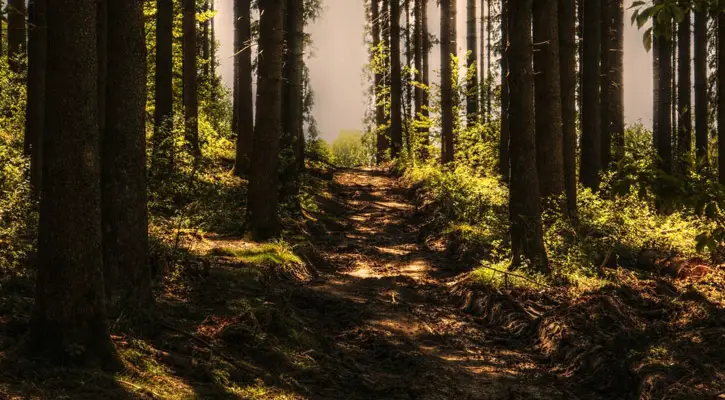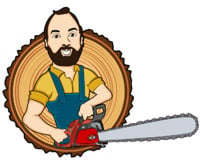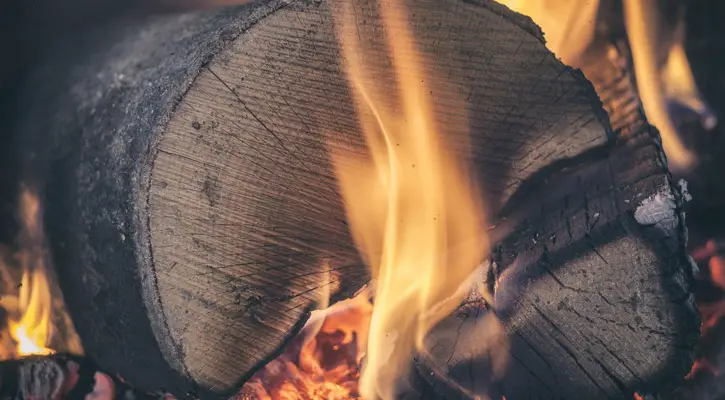Table of Contents
So, what are the best trees for firewood?
This is what we’ll go over in this guide,
No matter what, all trees can be burned as firewood.
But, not all woods burn the same.
Some burn hotter, others slower, some clean, and some smoky.
Below, you’ll find the answer to common questions people have about the various types of wood for firewood.
Such as, is poplar good for firewood? Is oak good for firewood? Is pine good for firewood? etc.
So, let’s dig in to find out what trees are the best and worse wood for your stove or fireplace. At the end, we’ll also go over some firewood seasoning tips.
By the way, you’re in the market for a new chainsaw to cut down your own trees for firewood, be sure to check out my guide on the top-rated chainsaws here. It includes reviews on the best of the best models for you to choose from.
I also have another guide specifically on the best chainsaw for firewood here. Check it out if you need a high-quality tool for the job.

Best Trees for Firewood (Answered)
Is Ash Good Firewood?
Ash is one of the best woods to use in a fire because it produces a long-lasting flame that puts out a lot of heat. Ash can even burn effectively if it’s moist or damp, making this a good choice when it comes to a fire.
Is Birch Good Firewood?
Birch isn’t a bad choice when it comes to firewood, as it produces a good amount of heat. If there’s a downside to this option, it’s that untreated birch can leave sap deposits in your fireplace or stove. These can be incredibly difficult to remove, so if you have other wood options, you might consider those instead.
Is Cedar Good Firewood?
Cedar burns slow and produces good heat, so it’s a good choice when it comes to firewood. It does have a tendency to split when being burned, which means that sap can build up in your stove or fireplace if you use this option often.
Is Cherry Good Firewood?
Cherry is a great choice for firewood when it’s in season. It has a long-lasting flame that gets incredibly hot. However, if cherry isn’t in season, it doesn’t make good firewood because it produces a lot of smoke and has high sap output.
Is Chestnut Good Firewood?
Chestnut isn’t good to use for firewood because it produces a small flame and doesn’t put out a lot of heat. It’s advised that you find other woods to burn instead of chestnut, especially if you’re trying to keep warm when the weather gets chilly.
Is Douglas Fir Good Firewood?
This is another firewood option that isn’t a good choice. It doesn’t produce a large flame or put out a lot of heat. In addition, if you use this often, it will leave behind sap deposits in your stove or fireplace that can be incredibly difficult to remove.
Is Elm Good Firewood?
Elm can be decent firewood if you get it completely dry. The issue is that this wood has a high moisture content, so it can take up to 2 years before the wood is dry enough to make it good firewood.
Is Hickory Good Firewood?
Hickory is one of the best woods you can find for burning. It holds very little moisture, which means it burns for a long time and puts out a lot of heat. Often, it burns hotter than maple, oak, or other popular hardwoods.
Is Locust Good Firewood?
If you’re looking for another really good wood to burn, you’ll want to get black locust. It burns slowly and produces a lot of heat as well as a long-lasting bed of coals that can keep adding warmth to any space.
Is Maple Good Firewood?
Maple makes good firewood because it’s slow-burning and puts off a lot of heat. When it comes to sugar maple, this can be a really good option because it doesn’t put off as many sparks or smoke as some other wood options.
Is Oak Good Firewood?
Once oak has become well seasoned, it’s a great option for firewood. It burns slowly, so it lasts for a long time and puts off a good deal of heat. The wait for this to season might be well worth it, as many believe that the fires created by oak can’t be beat.
Is Pine Good Firewood?
Pine is better when used as kindling than the main firewood in your fire. It has a lot of sap and resin, so it’s incredibly messy. Although it does have a delicious smell, so adding this to another wood option can add something special to your fire.
Is Poplar Good Firewood?
Poplar isn’t very dense, so it burns really fast, but it puts out a lot of heat. It can be a good choice when making fires early or late in the season when the temperatures are moderate. It can also be a good wood to mix in with other quality hardwoods to make a fire.
Is Spruce Good Firewood?
Spruce is a softer wood, so it’s not very dense. It burns quickly and doesn’t put out a lot of heat. Thus, it’s not a very good choice when it comes to adding this to your fire.
Is Sycamore Good Firewood?
As long as sycamore is completely dried out before you add it to your fire, it can be a great firewood option. Even when it’s properly dried, it has a tendency to burn quickly, but it puts out a lot of heat.
Is Walnut Good Firewood?
Walnut is a medium density wood that burns relatively easily. It has a great aroma, burns clean and puts out a decent amount of heat. Many consider this a middle-of-the-road choice because it doesn’t burn too fast or too slow and does a pretty good job of heating up a room.
Firewood Seasoning and Burning Tips
Now that you know what are the best trees for firewood, here are some tips on seasoning and burning that wood.
By the way, a 16 inch chainsaw is a great length for cutting firewood. So, if you don’t have that size tool in your shed, check out my best 16 inch chainsaw reviews to find a good deal.
Seasoning Firewood
Well-seasoned firewood is wood that has had the vast majority of moisture removed from it. If you see the wood steaming or hear hissing or popping as the wood burns, then there’s still a lot of moisture in it. In general, well-seasoned firewood has darkened ends and visible spits and cracks. It will also be lightweight and make a distinctive “clinking” sound when two pieces are knocked together.
How Much Moisture Is Too Much?
In general, if wood contains more than 25% moisture, it’s considered to be wet (also called green) and shouldn’t be placed in your fireplace or woodstove. Often, if you’re cutting fresh wood, it will contain approximately 50% moisture. It’s advised that you season the wood so that it contains less than 25% moisture before burning it.
What Is Heat Value?
When it comes to the heat value of wood, this is the amount of heat that is produced when the wood is burned. Here are how the values are broken down:
- High heat value – equivalent to the amount of heat produced when burning 200 to 250 gallons of fuel oil
- Medium heat value – equivalent to the amount of heat produced when burning 150 to 200 gallons of fuel oil
- Low heat value – equivalent to the amount of heat produced when burning 100 to 150 gallons of fuel oil
High Heat Value Trees for Firewood
- American beech
- Apple
- Ironwood
- Mesquite
- Red oak
- Shagbark hickory
- Sugar maple
- White ash
- White oak
- Yellow birch
Medium Heat Value Trees for Firewood
- American elm
- Black cherry
- Douglas fir
- Red maple
- Silver maple
- Tamarack
- White birch
Low Heat Value Trees for Firewood
- Aspen
- Cottonwood
- Hemlock
- Lodgepole pine
- Red alder
- Redwood
- Sitka spruce
- Western red cedar
- White pine
Summary of the Best Trees for Firewood
If you came here looking for answers on what the best trees for firewood, I hope you found it.
A lot of people wonder is poplar good for firewood? Is oak good firewood? How about spruce, is that good firewood?
Well, now you have the answers and can make the best decision for which type of trees to use for firewood in your home.
As a reminder, I have two guides to help you find the best chainsaw for your needs.
Take a look if you’re in the market for a new chainsaw.
You can find the overall top rated chainsaws here and the best chainsaw for firewood here.
I hope you found this guide on the best trees for firewood to be helpful.
Happy sawing!

Your pal,
Chainsaw Larry

